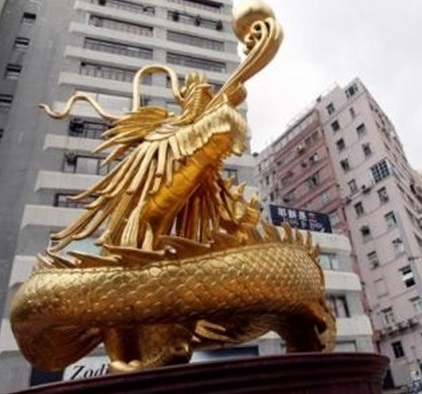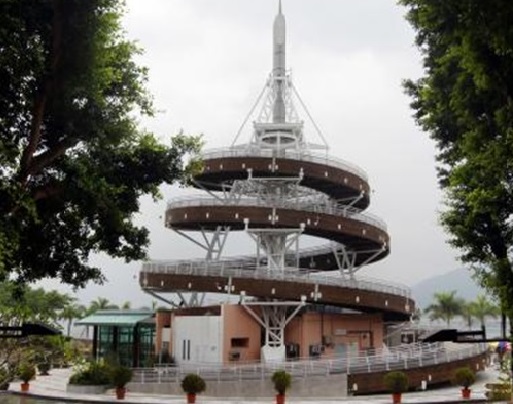Reviews & Articles
Hong Kong Deserves Better Public Art
Oscar Hing-kay HO
at 2:59pm on 10th April 2013


Captions:
1. The Golden Dragon sculpture.
2. The Tai Po Lookout Tower.
(原文以英文發表,評論香港的公共藝術。)
As announced in Chief Executive Leung Chun-ying's latest policy address, each of Hong Kong's 18 district councils is to receive HK$100 million for special building projects.
Since this includes public art projects, there is every reason to worry about how this money will be used. The city is hardly brimming with fantastic examples of public art. Quite the opposite, in fact.
The Golden Dragon sculpture at the busy junction of Leighton Road, Morrison Hill Road and Wong Nai Chung Road may be big and eye-catching, but that doesn't make it culturally meaningful.
A dragon might have some general linkage with being Chinese. But it does not have an engaging meaning for Hong Kong people, except that it brings to mind the decoration of some old-fashioned dim sum restaurants, or visits to overseas Chinatowns. It serves more as a political gesture, reminding us of our "cultural roots".
A more recent example of the Chinatown aesthetic is the archway for Temple Street in Yau Ma Tei. Temple Street itself is an icon that summarises the wild and colourful history of the grass-roots culture of Hong Kong. So imposing a traditional Chinese-style archway, which would more commonly be found in a Chinatown, on the place is more than an uncomfortable mismatch. It is a cultural violation that shows a total lack of awareness of the local cultural characteristics.
Even in terms of traditional architectural design, the archway fails. One could not find any justification for its disproportionally large and elongated columns, except for giving enough space to accommodate the long pieces of couplet. This structure is another iconic building project proudly commissioned by the district council.
Another (failed) attempt to build something grand as an iconic statement was implemented at Tai Po Waterfront Park. The spiral-shaped Tai Po Lookout Tower (called Unification Memorial Tower in Chinese) is an unnecessarily complex building with a heavily constructed tower top. Sticking out awkwardly in a beautiful seashore park, it looks like a contrived attempt to build something grand for political reasons.
Then there is the HK$1.2 million goose statue in Sham Tseng, which drew much criticism last month. The work, which is said to look more like a duck, is supposed to celebrate the local roast goose dish. The winning design was chosen from competition entries judged by councillors and government officials.
Will the latest injection of public funds help improve the situation? Judging by their track records, district councils are not the answer to the city's artistic needs. A sudden increase in pocket money does not necessarily bring on a sudden change of taste. Just walk along Jordan Road and you will see how "public icons" have failed under the leadership of our district councils.
Sticking out in the middle of pedestrian path on Jade Street is a sculpture of half-cut jade. There is nothing visually appealing about the sculpture, but at least it manages to tell visitors they are on a street that sells jade. The work is installed on a disproportionally large pedestal. The unusual size is needed for the prominent display of the names of the sponsors and the council members involved. Apparently this act of self-promotion is important enough to override the art.
Over the last decade, the arts community of Hong Kong has witnessed a substantial growth of investment in arts and culture. Art appears to be taken seriously in this city, and across the region, too.
Worried by the recent economic downturn, many Asian governments - especially those of Hong Kong, South Korea, Singapore and Taiwan - have become desperate to seek new economic solutions to replace their dying industries.
The fanciful invention of the term "creative industries" appeared at the right moment. It provided a new direction for economic development.
Arts and culture, which are regarded as essential ingredients in building creative industries, have received unprecedented attention. Cultural projects large and small are popping up like weeds, including the West Kowloon Cultural District and the Central Police Station projects.
Tertiary institutions are pumping out various programmes for the nurturing of "cultural software". Never before has our city been so captivated by arts and culture.
A by-product of this is an effort to manufacture "spectacle".
We all love having impressive cultural icons to present to our visitors. But they cannot be achieved simply by pumping money into the process. There are two essential qualities that make an icon successful. Firstly, it needs to be artistically outstanding. (This does not mean it has to utilise the global language of so-called "contemporary art".)
Secondly, and more importantly, it needs to have a profound, commonly shared cultural significance. It should be related to the historical and cultural experiences of a particular people in a particular place.
Could we try something that might not be sensational or grand, for a change? An icon doesn't always have to be spectacular. It just needs to be something that, in the long run, will benefit the community, especially those who really need the nourishment of culture.
Art can be simple, humble and yet still meaningful. We have to be willing to look at it differently. Why can't art be a joyful act of splashing paint onto paper by ordinary folks? Or an opportunity to bring kids in the neighbourhood together for a joint project involving singing, dancing, and voicing their concerns?
We could use the arts to build a sense of community pride, to encourage some communal interaction, to provide channels for minority communities to garner awareness, or to help new immigrants build a sense of confidence through their artistic articulation.
Art should satisfy not just the educated and the elite, but also the poor and underprivileged. They need more than financial support; they also need opportunities to prove that they are individuals capable of articulation, creative expression, building relationships and making critiques.
So can we stop building these grand, ugly objects that are polluting our environment and spend the money on something solid and meaningful instead?
A version of this essay was published in the South China Morning Post, 26 March 2013.
